Garden Bench Design Plans: Stylish & Functional Outdoor Seating
Published: 1 Aug 2025
Introduction
A garden bench combines aesthetics and practicality in any outdoor space. It could be a small patio, a large backyard or a small balcony. The right garden bench can accentuate the elegance of the space whilst serving as comfortable seating. It is important to have outdoor seating as it helps to make the area approachable and usable, which families and friends can make use of to relax and spend quality time together.
This article explicates different designs and plans for a garden bench, concentrating on their style and functionality as outdoor seating. This guide is packed with creative and practical do-it-yourself solutions for people seeking traditional wooden benches, modern concrete seating or even multi-purpose garden benches which serve as both seating and storage. Provided the proper materials are used, planning is thorough and the design is done with precision, the garden bench can serve as a prime centerpiece and a comfortable seating area.
What Makes Stylish and Functional a Design of a Garden Bench?
Achieving style and functionality for a garden bench involves an integrated approach to both elements of beauty and utility. The proper design complements your outdoor space while ensuring comfort and durability. Here are some elements which are essential to consider:
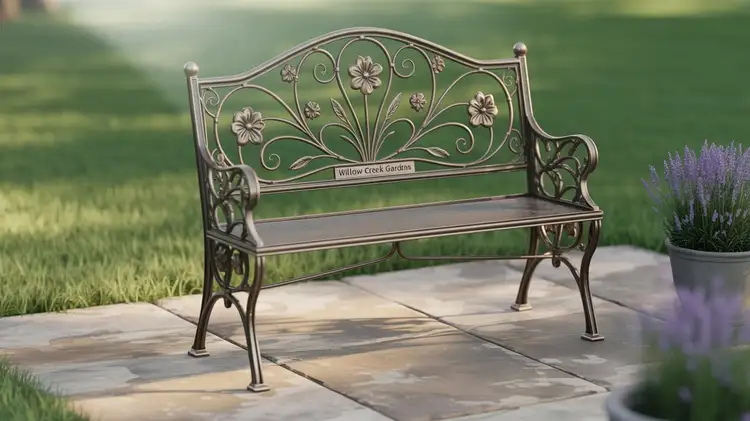
1. Materials
The material selected for the garden bench has great influence on its aesthetics and also its lifetime. Some of the common garden bench materials include:
- Wood: Bench made of wood are classic and versatile as they come in different styles and finishes. Teak, cedar and pine are some of the commonly used woods for garden benches.
- Metal: known for their modern appeal and durability. Metal benches are made of wrought iron, steel and aluminum.
- Concrete: offer a contemporary minimalist aesthetic. These benches are extremely durable with a much longer life span than the average garden bench.
- Recycled Materials: These are eco friendly and sustainable materials that can be designed into unique garden benches making them responsible for protecting the environment.
2. Design and Shape
The nature and form of your garden or patio bench is defined by how well it blends with the accompanying furniture. Some common designs are:
- Traditional: The seats often have unique back rests, arm rests and intricate woodwork or metal scrollwork.
- Modern: Concrete, metal and sleek wood are characteristic of modern styled benches with their simple and minimalistic approach.
- Storage Benches: These functional benches have a seating area which doubles as a compartment for storage, making them ideal for gardening tools, cushions and other items used outdoors.
3. Comfort
A bench is only as good as its comfort level. Enhancing the seating experience can be as simple as adding armrests, padding or a contoured back. Weather-resistant, quick-drying and easy to clean fabrics are preferable for outdoor cushions.
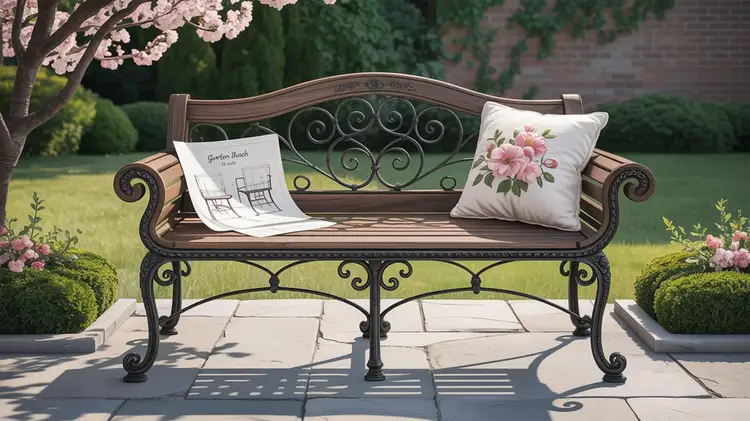
Garden Bench Design Plans for Various Areas
Garden benches can be designed with consideration of the space available for seating and how you plan to utilize the garden area. Here are some designs for different spaces:
1. Designs of Small Garden Benches
In small gardens or patios, space can sometimes be a constraint. This does not mean functional seating cannot be incorporated. Here are some options:
- Inbuilt Benches: An inbuilt bench can be custom made to fit in a corner or along a wall which provides ample seating while saving space.
- Foldable Benches: These benches suit small outdoor areas as they can be stored when not in use.
- Garden Bench With Planters: These types of benches have planter boxes which are built into the arms or the backrests, thus providing seating while doubling as greenery.
2. Designs of Large Garden Benches
If you are fortunate to have a large garden or patio space, then you can try out some of the bold and elaborate designs. Consider the following suggestions:
- Circular Benches: Semi circular and circular garden benches create more inclusive seating which furthers social interaction.
- Double-Sided Benches: These garden benches are suitable for large parks since people can sit opposite and converse comfortably.
- Outdoor Sofas with Cushions: Outdoor sofas and benches offer seating similar to living room furniture but outside—they transform an area into a room and can seat multiple people.
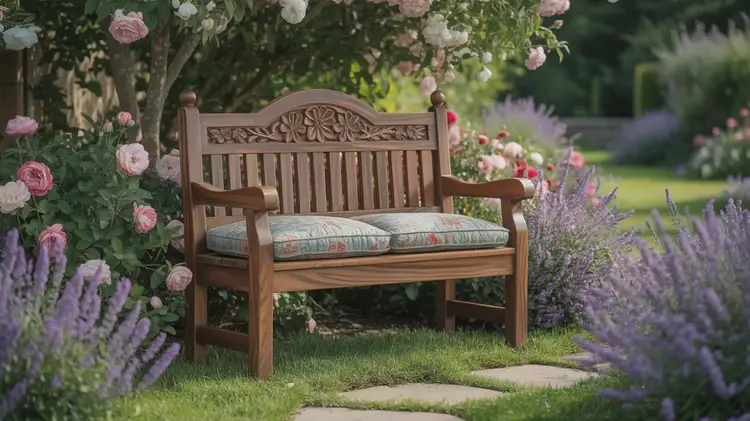
3. Seating with a View
Framing a beautiful view from your garden with a bench can further enhance the experience. Strategically placing benches with panoramic exposure to the garden, pond or landscape creates unobstructed vantage points, enhancing the vistas.
- Bench by the Pond: Simple wooden benches placed next to ponds or fountains let one savor the soothing sounds of water while sitting comfortably.
- Lookout Benches: The high backs of these benches provide support while viewing the garden or landscape, making them ideal for leisurely afternoons spent outside.
Materials for Designing a Garden Bench
When designing a garden bench, the materials selected impact how long it lasts as well as if it is pleasing to the eye. A list of some materials commonly used in garden benches is provided below:
1. Wooden Garden Benches
A wooden garden bench is a traditional selection and sitting on it is a comfortable experience. Also, a wooden bench can blend with a wide variety of outdoor settings. Types of wood suitable for garden benches include:
- Teak: This wood has natural oils and is resistant to water, thus making it a good option for outdoor furniture.
- Cedar: This wood has natural insect and decay resistance making it suitable for the outdoors.
- Pine: While less expensive, this wood does need to be treated for outdoor use. This softwood may need more upkeep compared to hardwoods.
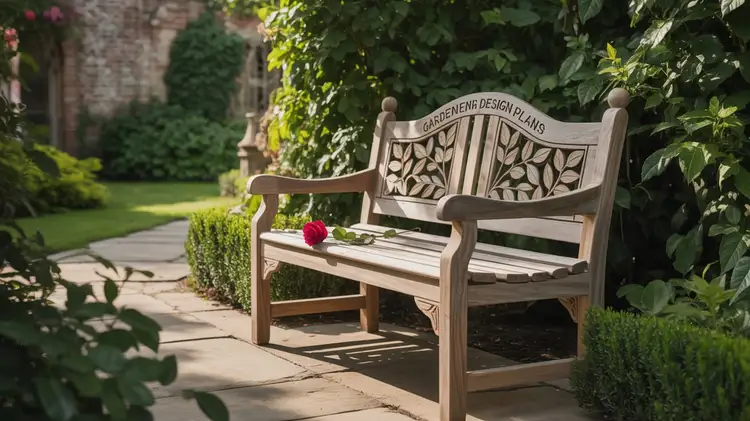
Stains or paints can be applied to wooden benches to enhance appearance and provide some elemental protection. Regardless of treatment, those wooden benches do require periodic upkeep to prevent fading or weathering.
2. Metal Garden Benches
Metal benches often are more durable and can provide a modern or vintage aesthetic to the garden. For garden benches, metals such as wrought iron are common.
- Wrought iron: Usually, wrought iron benches are intricately designed making them suitable for ornate and traditional garden spaces.
- Aluminum: Aluminum benches are lightweight, rust-free and portable. They come in various finishes from matte to polished.
- Steel: Steel benches are extremely resilient and withstand harsh outdoor weather conditions, which makes them suitable for outdoor furniture.
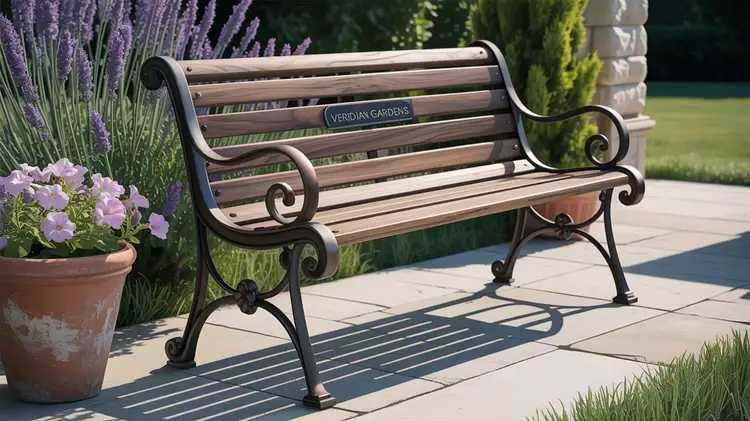
3. Concrete Garden Benches
Concrete benches are extremely tough and durable, adopting a contemporary, minimalist aesthetic. Their sturdiness makes them ideal for modern gardens or urban landscapes. Concrete benches can be shaped into different sizes, featuring smooth lines or textured surfaces, embodying a modern or rustic charm, respectively.
4. Recycled Materials
Benches crafted from recycled materials appeal to homeowners looking to be eco-friendly. They are made from used wood, plastic or metal, offering seating while minimizing waste. Designed with style and eco-friendliness in mind, these materials are effortlessly transformed into imaginative, sustainable pieces.
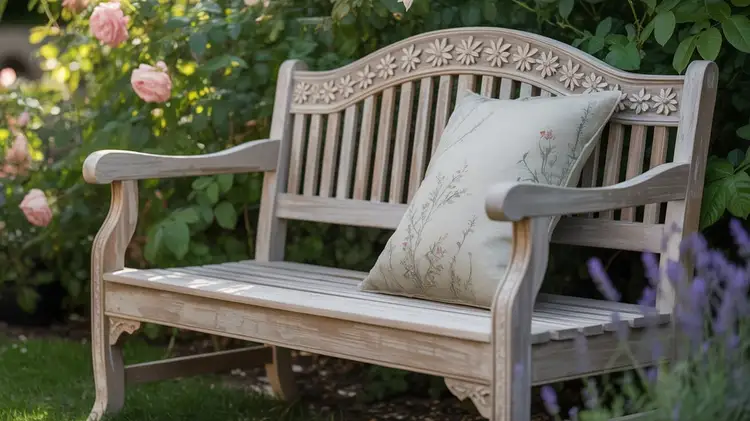
DIY Garden Bench Design Plans
If you want to create your own furniture, a DIY garden bench design gives you the chance to exercise your creativity. Below are the easy steps and tips to make a garden bench on your very own:
1. Materials You Will Need
- Screws or nails.
- Wood glue for extra strength.
- Cushions (optional).
- Outdoor stain or paint for protection.
- Sandpaper for smoothing rough edges.
2. Step-by-Step Guide
- Cut the Wood: With the right saw, cut the wood into back rest, seat and legs for the required dimensions.
- Attach the Seat: Add the back rest if desired after attaching the bench’s seat to the frame.
- Finishing the Bench: Sand the bench smooth to remove any rough patches and apply an outdoor stain or paint. Add finish of your choosing to outdoor graded wood to protect it against weather elements. Cushions and other seating accessories can be added after the finish has dried completely.
Garden Bench Design Plans for Every Budget
If you’re looking for a specific garden bench design, there are options available for every budget, whether you are looking for low cost or high grade materials, every dollar will be wisely allocated. Here is a breakdown on how to choose a design according to your budget.

1. Low Budget
- Wooden Bench with Basic Materials: One of the most affordable options from the list is a simple wooden bench constructed with pine or recycled wood. For added ease while sitting, cushions can be easily added on top.
- Repurposed Furniture: Transform old chairs or tables into a garden bench. This is a great way to get one-of-a-kind seating while staying cost-friendly.
2. Medium Budget
- Metal Bench with Simple Design: Consider this moderately priced option a metal garden bench with basic frame and affordable, yet stylish design. Wrought iron or aluminum are good options to integrate as they provide a good balance of price and quality.
- Wooden Bench with Storage: Design your bench with added compartments below the seat for outdoor tools or cushions by converting it into a basic chest or box. This addition provides extra storage, changing the functionality of your wooden bench.
3. High Budget
- Teak Bench with Custom Design: For an extravagant option, consider a garden bench crafted from teak wood. Teak is a beautiful and durable wood known for its resistance to water damage and insects, making it a luxurious choice for outdoor seating.
- Designer Concrete Bench: Finely polished concrete benches with different shapes and artistic finishes can transform a garden into a sophisticated area. These one-of-a-kind masterpieces will definitely draw attention to your garden.
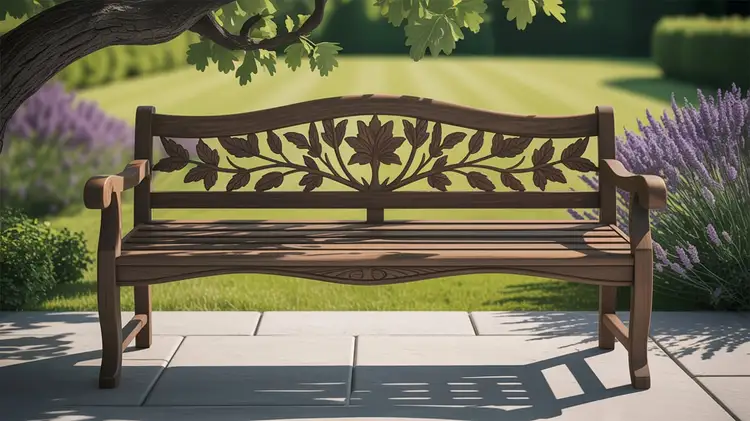
FAQs
The best material for a garden bench depends on your preferences. For a timeless aesthetic, wooden benches are unmatched, while metal benches give a modern feel and concrete benches are minimalist in nature. Function will determine which option you will choose.
Using outdoor fabric cushions will enhance comfort significantly. Additionally, a backrest with armrests makes the seating experience soothing and relaxing.
With proper tools and raw materials, a garden bench can easily be constructed from scratch. Simple designs such as a wooden bench are excellent for DIY enthusiasts.
Yes, many garden benches are constructed using weather-resistant materials such as treated wood, metal or concrete. These materials will withstand the test of time. Outdoor stains and paints also serve as protectants, helping the bench retain its appearance.
The maintenance of a bench involves cleaning and removing debris. Wooden benches require sealing on a consistent basis. Metal benches and concrete benches are a little easier to maintain, as they only need occasional rust treatment or a simple cleaning.





